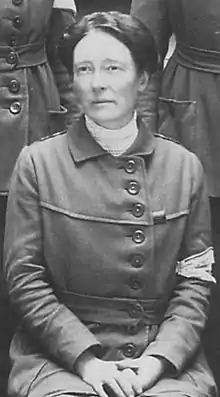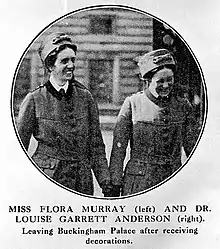Louisa Garrett Anderson
Louisa Garrett Anderson CBE (28 July 1873 – 15 November 1943) was a medical pioneer, a member of the Women's Social and Political Union, a suffragette, and social reformer. She was the daughter of the founding medical pioneer Elizabeth Garrett Anderson, whose biography she wrote in 1939.
Louisa Garrett Anderson CBE | |
|---|---|
 | |
| Born | Louisa Garrett Anderson 28 July 1873 Aldeburgh, Suffolk, England |
| Died | 15 November 1943 (aged 70) Penn, Buckinghamshire, England |
| Education | St Leonards School London School of Medicine for Women |
| Known for | Military hospitals Campaigning for women's rights and social reform |
| Relatives | Flora Murray (partner) Elizabeth Garrett Anderson (mother) Alan Garrett Anderson (brother) Millicent Fawcett (maternal aunt) |
| Medical career | |
| Profession | Physician and surgeon |
Anderson was the Chief Surgeon of the Women's Hospital Corps (WHC) and a Fellow of the Royal Society of Medicine. Her aunt, Dame Millicent Fawcett, was a British suffragist. Her partner was fellow doctor and suffragette Flora Murray. Her cousin was Dr Mona Chalmers Watson who also supported suffragettes and founded the Women's Army Auxiliary Corps.[1]
Early life and education
Louisa Garrett Anderson was the oldest of three children of Elizabeth Garrett Anderson, the first woman to qualify as a doctor in Britain, co-founder of the London School of Medicine for Women and Britain's first elected woman Mayor. Her father was James George Skelton Anderson, co-owner of the Orient Steamship Company with his uncle Arthur Anderson.[2] She was educated at St Leonards School in St Andrews and London School of Medicine for Women, where she received her Bachelor of Medicine and Bachelor of Surgery in 1898. Anderson received her Doctor of Medicine in 1900, enrolled in further postgraduate studies at Johns Hopkins Medical School and traveled to observe operations in Paris and Chicago.[3]
Early career
Despite her education, Anderson was unable to join a general major hospital, as attitudes at the time opposed female doctors treating both men and women. As a result, in 1902, she joined the New Hospital for Women, a women's-only hospital founded by her mother which treated women and children. Anderson first worked as a surgical assistant and later as a senior surgeon. She performed gynaecological and general operations, and co-published a paper with the hospital pathologist in 1908 discussing her hysterectomy operations and dissecting the 265 cases of uterine cancer treated at the New Hospital for Women.[3]
Suffragette activity
.jpg.webp)
From 1903, Anderson had been active in organizations affiliated with the NUWSS, which advocated for gaining voting rights through peaceful means. Frustrated by the lack of progress on voting rights, in 1907, she became an active member of the more radical WSPU.[4] On 18 November 1910, Anderson joined her mother, Emmeline Pankhurst, Alfred Caldecott, Hertha Ayrton, Mrs Elmy, Hilda Brackenbury, Princess Sophia Duleep Singh, and 300 women to petition Prime Minister Asquith for voting rights.[5] The protest became known as Black Friday, due to the violence and sexual assault the protesters faced from the police and male bystanders.[6] More than one hundred women were arrested, including Anderson, but all were released without charge.[6] In 1912, she was imprisoned in Holloway, briefly, for her suffragette activities which included breaking a window by throwing a brick. In 1914, Anderson joined Agnes Harben and the new group of women and men: H. J. Gillespie, Gerald Gould, Bessie Lansbury and George Lansbury, Mary Neal, Emmeline Pethick-Lawrence, Julia Scurr and John Scurr, Evelyn Sharp, and Edith Ayrton, Louise Eates and Lena Ashwell[7] in starting the United Suffragists which grew to have branches in London, Liverpool and Edinburgh.[5]
Medicine – WW1
When the First World War broke out, Anderson and Flora Murray founded the Women's Hospital Corps (WHC), and recruited women to staff it.[8] Believing that the British War Office would reject their offer of help, and knowing that the French were in need of medical assistance, they offered their assistance to the French Red Cross.[9] The French accepted their offer and provided them the space of a newly built hotel in Paris as their hospital.[10] Murray was appointed Médecin-en-Chef (chief physician) and Anderson became the chief surgeon.[9]
Murray reported in her diary that visiting representatives of the British War Office were astonished to find a hospital run successfully by British women, and the hospital was soon treated as a British auxiliary hospital rather than a French one.[9] In addition to the hospital in Paris, the Women's Hospital Corps also ran another military hospital in Wimereux.[10]
In January 1915, casualties began to be evacuated to England for treatment. The War Office invited Murray and Anderson to return to London to run a large hospital, the Endell Street Military Hospital (ESMH), under the Royal Army Medical Corps. ESMH treated almost 50,000 soldiers between May 1915 and September 1919 when it closed.[10]
At Endell, Anderson and the hospital pathologist, Helen Chambers, pioneered a new method of treating septic wounds, an antiseptic ointment called BIPP (bismuth, iodoform, and paraffin paste). The paste had been invented by James Rutherford Morison. After positive results from some initial tests by Anderson, Morison asked her and Chambers to run a larger trial of BIPP in 1916. Anderson published case studies in The Lancet, concluding that this method saved patients pain and was better than the Carrel-Dakin method, which used a more powerful antiseptic but had to be frequently reapplied to be effective. Since bandages could be left on for longer, the BIPP method reduced time spent changing bandages by as much as 80%.[11] BIPP was widely adopted by surgeons for the rest of the war, although opinion among doctors remained divided as to the best method for wound treatment. Despite continued debate, BIPP was also used in the Second World War and continues to be in use today in ear, nose, throat, maxillofacial, and neurosurgery procedures.[12]
Death
Anderson is buried at Holy Trinity Church with Murray, near to their home in Penn, Buckinghamshire. The inscription on the gravestone reads "Louisa Garrett Anderson, C.B.E., M.D., Chief Surgeon Women's Hospital Corps 1914–1919. Daughter of James George Skelton Anderson and Elizabeth Garrett Anderson of Aldeburgh, Suffolk. Born 28th July 1873, died November 15. 1943. We have been gloriously happy."[13]

Archives
The archives of Louisa Garrett Anderson are held at The Women's Library at the Library of the London School of Economics, ref. 7LGA].[14][15]
Posthumous recognition
Anderson's name and picture (and those of 58 other women's suffrage supporters) are on the plinth of the statue of Millicent Fawcett in Parliament Square, London, unveiled in 2018.[16][17][18]
References
- "Back in the day: Mona Chalmers - general in battle with the sexists". The National. Retrieved 19 December 2020.
- Manton, Jo (1965). Elizabeth Garrett Anderson: England's First Woman Physician. 217-218.CS1 maint: location (link)
- Moore, Wendy (2020). No Man's Land: The Trailblazing Women Who Ran Britain's Most Extraordinary Military Hospital During World War I. Basic Books. p. 34.
- Moore, Wendy (2020). No Man's Land: The Trailblazing Women Who Ran Britain's Most Extraordinary Military Hospital During World War I. Basic Books. p. 36.
- Atkinson, Diane (2018). Rise up, women! : the remarkable lives of the suffragettes. London: Bloomsbury. pp. 222, 453. ISBN 9781408844045. OCLC 1016848621.
- Moore, Wendy (2020). No Man's Land: The Trailblazing Women Who Ran Britain's Most Extraordinary Military Hospital During World War I. Basic Books. p. 38.
- Crawford, Elizabeth (1999). The Women's Suffrage Movement: A Reference Guide, 1866-1928. UCL Press. pp. 269–271. ISBN 978-1-84142-031-8.CS1 maint: date and year (link)
- "Louisa Garrett Anderson and Flora Murray: Redefining gender roles in military medicine". The Bulletin. 1 April 2019. Retrieved 18 July 2020.
- Leneman, L (April 1994). "Medical women at war, 1914-1918". Medical History. 38 (2): 160–177. doi:10.1017/s0025727300059081. ISSN 0025-7273. PMC 1036842. PMID 8007751.
- GEDDES, JENNIAN F (1 January 2007). "Deeds and Words in the Suffrage Military Hospital in Endell Street". Medical History. 51 (1): 79–98. doi:10.1017/s0025727300000909. ISSN 0025-7273. PMC 1712367. PMID 17200698.
- Moore, Wendy (2020). No Man's Land: The Trailblazing Women Who Ran Britain's Most Extraordinary Hospital During World War I. Basic Books. p. 293.
- Moore, Wendy (2020). No Man's Land: The Trailblazing Women Who Ran Britain's Most Extraordinary Military Hospital During World War I. Basic Books. p. 295.
- Iain MacFarlaine (21 June 2002). "Louisa Garret Anderson". Medical Pioneer, Social Reformer. Find a Grave. Retrieved 17 August 2011.
- Science, London School of Economics and Political. "Library". London School of Economics and Political Science.
- "Overview". twl-calm.library.lse.ac.uk. Retrieved 8 June 2020.
- "Historic statue of suffragist leader Millicent Fawcett unveiled in Parliament Square". Gov.uk. 24 April 2018. Retrieved 24 April 2018.
- Topping, Alexandra (24 April 2018). "First statue of a woman in Parliament Square unveiled". The Guardian. Retrieved 24 April 2018.
- Saul, Heather (24 April 2018). "Millicent Fawcett statue unveiling: the women and men whose names will be on the plinth". iNews. Retrieved 25 July 2020.
Other sources
- Geddes, Jennian F (November 2008). "Louisa Garrett Anderson (1873–1943), surgeon and suffragette". Journal of Medical Biography. 16 (4): 205–14. doi:10.1258/jmb.2007.007048. PMID 18952990. S2CID 704972.
- Geddes, Jennian F (January 2007). "Deeds and words in the suffrage military hospital in Endell Street". Medical history. 51 (1): 79–98. doi:10.1017/s0025727300000909. PMC 1712367. PMID 17200698.
External links
| Wikimedia Commons has media related to Louisa Garrett Anderson. |
- Elizabeth Garrett Anderson
- BBC page on Elizabeth Garrett Anderson
- Papers of Louisa Garrett Anderson
- Pictures at the National Portrait Gallery
- Biog and image of her gravestone. Ian MacFarlaine
- Women in the Great War – Women's Organisations in the British Army
- Wellcome Library – Military Hospital at Endell Street
- PubMed Central – Deeds and Words in the Suffrage Military Hospital in Endell Street – including photographs